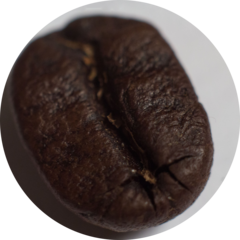10 DIFFERENCES BETWEEN ROBUSTA & ARABICA COFFEE

You may have noticed that some coffee bag labels brag about the fact that their coffee beans are 100% Arabica. Although it does sound like something magicians say, it isn’t gibberish – it refers to the type of coffee species in which the beans are from.
There are over 100 coffee species, however the two main ones that are widely produced and sold are: Coffea Arabica and Coffea Canephora (also known as Coffea Robusta).
Here’s a list featuring 10 differences between the two coffee species:
1. The most commonly known: Taste. Often Robusta has its taste described as burnt tires or rubbery, which… sounds disgusting (can you imagine one of our taste swatches on the front page being a burnt tire?). Why the bad taste?
2. One reason that the taste isn't as good for Robusta is that it has more caffeine compared to Arabica. Which may sound like a positive thing but caffeine carries a bitter taste which makes it an unpleasant drink. In fact the Robusta bean has 2.7% caffeine content, almost double the 1.5% of Arabica.
3. Lipid & Sugar content: As mentioned here, Arabica contains almost 60% more lipids and almost twice the concentration of sugar than Robusta. This factor also probably has a big impact on why we prefer the taste of Arabica.
4. From a price perspective, green beans of Robusta is about half the price of Arabica green beans on the commodity market. (Robusta vs. Arabica)
5. Robusta is easier to tend to on the farm, has a higher yield and is less sensitive to insects - the extra caffeine is a chemical defense for the coffee seed as the quantity in the Robusta is toxic to bugs.
All of these factors help bring up the supply and lower the input costs for farmers to produce. With this more attractive price point, a lot of roasters back in the day would add Robusta to their blend in an attempt to reduce their costs and increase their profits. When coffee was initially sold in the 1900s the quality of coffee slowly and slowly deteriorated in an effort for companies to squeeze the most profit.
6. Where you’ll find it: Nowadays, it’s not often you’ll find Robusta in a coffee blend. If you’re drinking instant coffee? Well, that’s probably all Robusta… but you probably don’t care very much about taste. In your espresso blend? That’s a mixed bag. Literally. Oddly enough, Robusta is still widely used as part of espresso blends – specifically Italian style blends. It is said to help improve the Crema. However, generally at a detriment to the taste, which in our opinion the priorities may be out of wack.
One thing to note is despite the association with Arabica of being higher quality, and Robusta as being lower quality, it’s not always the case. Top notch specialty Robusta coffee will usually taste as good as or better than low end Arabica. However, high end Robusta isn’t widely used or available. Rather, Robusta is usually used as a filler or cost reducer.
7. The Shape: Robusta beans are much more circular, whereas Arabica are more oval.
8. Plant Height: Arabica usually grows between 2.5 – 4.5 meters compared to the 4.5 – 6 meter height of Robusta.
9. Chlorogenic acid (CGA) content: unfortunately, isn’t true – however something that is actually a part of coffee is CGA. It’s a significant antioxidant and an insect deterrent. Robusta is 7-10% CGA and Arabica has 5.5-8% CGA.
10. Cultivation: About 75% of the world’s coffee production is Arabica, about 25% being Robusta. Brazil is the most significant Arabica producer and Vietnam produces the most Robusta.
According to www.theroasterspack.com
| TTM VIET NAM TRADING AND SERVICE COMPANY LIMITED Add: No. 5, Line L, Group 15, Mai Dich culture & art quarter, Mai Dich ward, Cau Giay district, Hanoi, Vietnam Tel: (+84) 936.22.26.29 (Whatsapp / Wechat / Zalo / Viber) * Email: minhtt@ttmvietnam.com.vn |
Design by VNTDC |
